
The Cincinnati, Richmond & Muncie Depot is a restored train station in Muncie, Indiana, United States. Built in 1901, it was acquired by the Chesapeake and Ohio Railway in 1910. The station was used for passenger train service throughout the 20th century and was added to the National Register of Historic Places in 1997. It is currently used as a visitor center and office for the adjacent Cardinal Greenway.

Beech Grove Cemetery is a large historical cemetery and national historic district located at Muncie, Indiana. It was listed on the National Register of Historic Places in 1999.

The Carnegie Library is a historic Carnegie library located at Muncie, Indiana, United States. The building houses the Local History & Genealogy collection and an open computer lab. The facility also provides wireless access and a meeting room for local groups to reserve. It is one of four branches that make up the Muncie Public Library System. The building was made possible through a financial donation to the City of Muncie by Andrew Carnegie to expand their library system throughout the community. The foundation for Carnegie Library was built in 1902 and the building opened to the public in 1904. It has been in continuous use as a library since its opening. The building is located in downtown Muncie at the intersection of Jackson and Jefferson.

Judson Building is a historic apartment building located at Muncie, Delaware County, Indiana. It was built about 1900, and is a two-story, five bay by nine bay, Romanesque Revival style red brick building. It has a flat roof, segmental arch openings, and projecting angular bays.
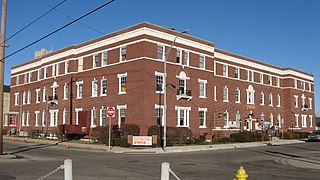
YWCA is a historic YWCA building located at Muncie, Delaware County, Indiana. It was built in 1925, and is a three-story, five bay by three bay, restrained Colonial Revival style brick building with limestone detailing. It has swimming pool in the basement, meeting and recreation rooms on the first floor, and sleeping rooms on the second and third floors.

City Hall was a historic city hall building located at Muncie, Delaware County, Indiana. It was built in 1925, and was a three-story, "L"-shaped, Renaissance Revival style brick building with terra cotta detailing. It has been demolished.

Goldsmith C. Gilbert Historic District is a national historic district located at Muncie, Delaware County, Indiana. It encompasses 75 contributing buildings and is located in the oldest residential section of Muncie. The district includes notable examples of Late Victorian, Colonial Revival, and Bungalow / American Craftsman style architecture. Located in the district is the separately listed J.C. Johnson House. Other notable buildings include the A.L. Johnson House, Meeks Mortuary Building, Joseph Hummel House, and Miller Livery (1916).
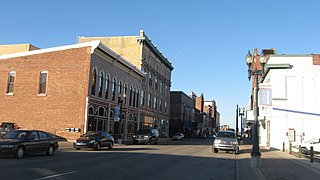
Walnut Street Historic District is a national historic district located at Muncie, Delaware County, Indiana. It encompasses 66 contributing buildings and 1 contributing object, and is located in the central business district of Muncie. The district includes notable examples of Italianate, Late Victorian, Colonial Revival, and Beaux-Arts style architecture. Located in the district are the separately listed Moore-Youse-Maxon House, Roberts Hotel, and Goddard Warehouse. Other notable buildings include the Patterson Bock, McNaughton Block (1901-1903), Mitchell Block (1909), American National Bank Building (1924), Marsh Block (1888), and the Old Post Office designed by the Office of the Supervising Architect under James Knox Taylor.

Old West End Historic District is a national historic district located at Muncie, Delaware County, Indiana. It encompasses 273 contributing buildings in a predominantly residential section of Muncie. The district largely developed between about 1880 and 1915, and includes notable examples of Late Victorian style architecture. Notable buildings include Temple Beth-El (1922), First Church of Christ Scientist, Wittmore Apartments, Martin Sisters House (1879-1880), Christian Church / Wesleyan Chapel (1875), Vandercook House (1887), First English Lutheran Church, Muncie Hospital and Invalids Home (1890), and Ira Hunter House.

Westwood Historic District is a national historic district located at Muncie, Delaware County, Indiana. It encompasses 83 contributing buildings and 1 contributing site in a predominantly residential section of Muncie. The district developed after 1923, and includes notable examples of Colonial Revival, Tudor Revival, and Bungalow / American Craftsman style architecture. Notable buildings include the William H. Ball House (1925), Alexander Bracken House (1937), Michael Broderick House (1928), Bennett Heath House, and Fred Kencht House (1932).

Riverside Historic District is a national historic district located at Muncie, Delaware County, Indiana. It encompasses 74 contributing buildings and 1 contributing structure in a predominantly residential section of Muncie. The district developed between about 1895 and 1949, and includes notable examples of Colonial Revival, Tudor Revival, and Bungalow / American Craftsman style architecture.

Meeks Avenue Historic District is a national historic district located at Muncie, Delaware County, Indiana, USA. It encompasses 25 contributing buildings in a predominantly residential section of Muncie. The district developed between about 1904 and 1939, and includes notable examples of Bungalow / American Craftsman style architecture. A notable building is a service station constructed in 1939.

Kirby Historic District is a national historic district located at Muncie, Delaware County, Indiana. It encompasses 25 contributing buildings in a predominantly residential section of Muncie. The district developed between about 1839 and 1930, and includes notable examples of Greek Revival and Colonial Revival style architecture. Notable buildings include the Thomas Kirby House (1839), William F. Spencer House (1909), John Fitzgibbons House (1918), Theopharia A. Hough House (1909), Pearl Hopkins House (1893), and Edward R. Templar House (1905).

Minnetrista Boulevard Historic District is a national historic district in the city of Muncie, in Delaware County, East Central Indiana. It is located along the northeast side of Minnetrista Boulevard and the north bank of the White River, about a mile north of downtown Muncie.
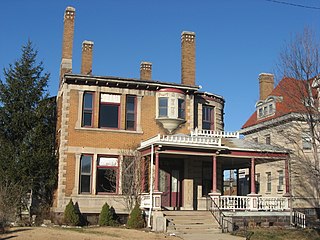
J. C. Johnson House is a historic home located at Muncie, Delaware County, Indiana. It was designed by the noted Fort Wayne architectural firm Grindle & Weatherhogg and built in 1897. It is a large 2+1⁄2-story brick dwelling with Queen Anne and Romanesque Revival style design elements. It features a projecting tower, two-story bay constructed of limestone, four slender chimneys, and a slate roof with decorative ridge trim.
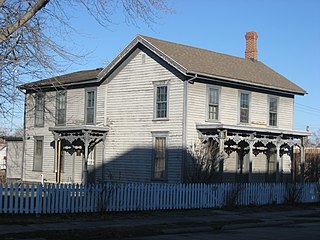
The Moore–Youse–Maxon House, also known as the Moore–Youse Home Museum, is a historic home located at Muncie, Delaware County, Indiana. It was built about 1860, and is a two-story, three bay, vernacular Greek Revival style frame dwelling. It features a rebuilt front porch with sawnwork and brackets. It has a two-story rear addition. The house remained in the same family from 1864 to 1982. The building is operated by the Delaware County Historical Society as a historic house museum.

Boyce Block is a historic commercial building located at Muncie, Delaware County, Indiana. It was built in 1880, and is a two-story, brick building. The building features an elaborate parapet. Since 1904, the building has housed a theater.

Hills and Dales Historic District is a national historic district located at West Lafayette, Tippecanoe County, Indiana. The district encompasses 136 contributing buildings and 39 noncontributing buildings in a predominantly residential section of Lafayette, platted in 1922–1924. It developed between about 1911 and 1951 and includes representative examples of Colonial Revival, Tudor Revival, French Renaissance, and Ranch style architecture. Notable contributing buildings include the Haniford House, Herbert Graves House,, and Marion J. Eaton House.
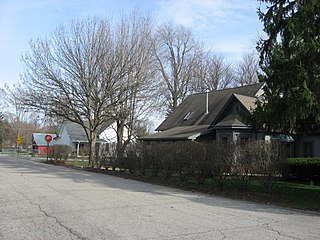
New Augusta Historic District is a national historic district located at Indianapolis, Indiana. It encompasses 114 contributing buildings, 1 contributing structure, and 1 contributing object in a railroad oriented village in Indianapolis. The district developed between about 1852 and 1939, and includes representative examples of Italianate and Bungalow / American Craftsman style architecture. Notable contributing buildings include the Odd Fellows Building, Hopewell Evangelical Lutheran Church, Salem Lutheran Church (1880), and New Augusta Depot. It is located west of Augusta.

St. Joseph Neighborhood Historic District is a national historic district located at Indianapolis, Indiana. The district encompasses 57 contributing buildings in a predominantly residential section of Indianapolis. It was developed between about 1855 and 1930, and include representative examples of Italianate and Queen Anne style architecture. Located in the district are the separately listed Bals-Wocher House, William Buschmann Block, Delaware Court, Pearson Terrace, and The Spink. Other notable buildings include the Christian Place complex, Fishback-Vonnegut-New House, Henry Hilker House, Apollo-Aurora Rowhouses, Israel Traub Store, and Lorenzo Moody House.
























